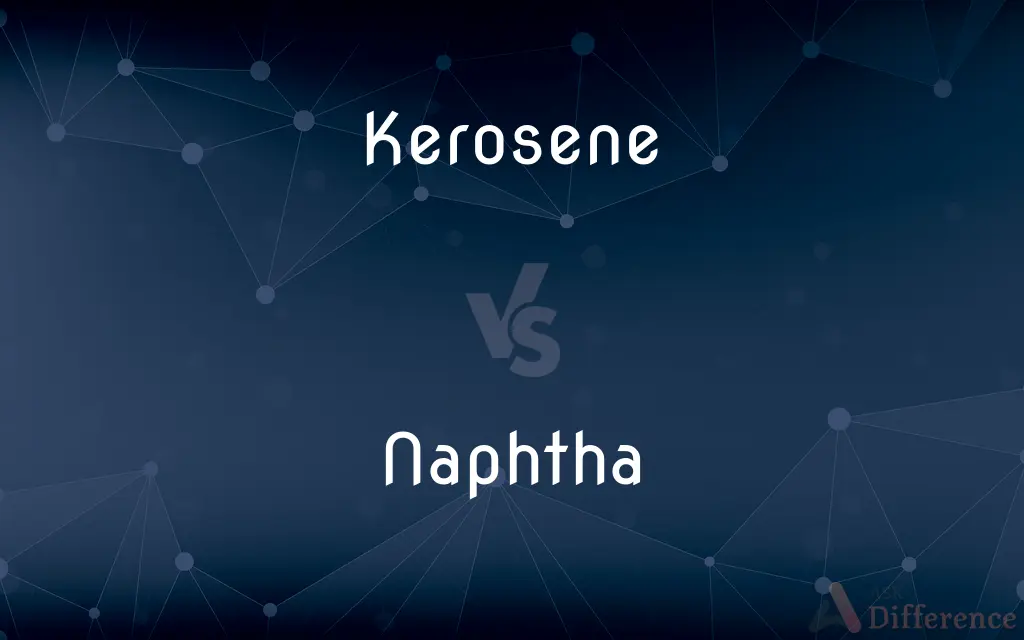Kerosene vs. Naphtha — What's the Difference?
By Tayyaba Rehman — Updated on December 30, 2023
Kerosene is a light petroleum distillate commonly used as fuel in heating, lamps, and aviation, while naphtha is a more volatile petroleum distillate used as a solvent and in making various chemicals.

Difference Between Kerosene and Naphtha
Table of Contents
ADVERTISEMENT
Key Differences
Kerosene is a combustible hydrocarbon liquid, derived from petroleum. It is commonly used as a heating fuel, in jet engines, and in lamps. Naphtha is also a petroleum product but is more volatile and less viscous than kerosene, often used as a solvent or as a raw material in the petrochemical industry.
In terms of chemical composition, kerosene consists of carbon chains typically containing 12 to 15 carbon atoms, while naphtha contains shorter carbon chains, usually with 5 to 9 carbon atoms. This difference in carbon chain length affects their physical properties and applications.
Kerosene is known for its relatively high flash point, making it safer to store and handle compared to naphtha, which is more flammable and volatile due to its lower flash point.
While kerosene is widely used for heating and as jet fuel, naphtha's primary uses include being a feedstock for producing high-octane gasoline and various chemicals in the petrochemical industry.
Kerosene has a specific, sometimes unpleasant odor and is typically clear or slightly yellow. Naphtha, however, is a colorless liquid and its composition can vary greatly depending on its source and intended use.
ADVERTISEMENT
Comparison Chart
Composition
Carbon chains with 12 to 15 atoms
Carbon chains with 5 to 9 atoms
Common Uses
Heating, jet fuel, lamps
Solvent, petrochemical feedstock
Flammability
Higher flash point, less flammable
Lower flash point, more flammable
Physical Properties
Less volatile, clear or slightly yellow
Highly volatile, colorless
Industry Application
Heating, aviation
Petrochemical, gasoline production
Compare with Definitions
Kerosene
A common fuel for lamps and heaters.
Kerosene lamps were used before the advent of electricity.
Naphtha
A volatile liquid from petroleum distillation used as a solvent.
Naphtha was used to clean the industrial equipment.
Kerosene
A petroleum-derived liquid used in aviation.
The jet was fueled with a type of kerosene.
Naphtha
A component in the production of plastics and synthetic rubber.
Naphtha is crucial in manufacturing certain types of plastics.
Kerosene
A combustible hydrocarbon liquid used as a fuel.
We filled the heater with kerosene to warm the room.
Naphtha
Characterized by a low flash point and high flammability.
Naphtha requires careful handling due to its flammability.
Kerosene
Known for its safety due to a high flash point.
Kerosene is preferred in heaters for its safety features.
Naphtha
Used in the production of high-octane gasoline.
Refineries convert naphtha into high-quality gasoline.
Kerosene
Sometimes used as a cleaning agent or solvent.
Kerosene can effectively remove grease from metal parts.
Naphtha
Naphtha ( or ) is a flammable liquid hydrocarbon mixture. Mixtures labelled naphtha have been produced from natural gas condensates, petroleum distillates, and the distillation of coal tar and peat.
Kerosene
Kerosene is a combustible hydrocarbon liquid which is derived from petroleum. It is widely used as a fuel in aviation as well as households.
Naphtha
Any of several highly volatile, flammable liquid mixtures of hydrocarbons distilled from petroleum, coal tar, and natural gas and used as fuel, as solvents, and in making various chemicals. Also called benzine, ligroin, petroleum ether, white gasoline.
Kerosene
A thin oil distilled from petroleum or shale oil, used as a fuel for heating and cooking, in lamps, and as a denaturant for alcohol. Also called coal oil.
Naphtha
(Obsolete) Petroleum.
Kerosene
A thin colorless to straw-colored petroleum-based fuel heavier than gasoline/petrol or naptha but lighter than diesel, used primarily as jet fuel but also for heating and lighting in some remote or impoverished areas.
The kerosene lasted all winter, so the furnace kept us always warm.
Naphtha
(dated) Naturally occurring liquid petroleum.
Kerosene
An oil used for illuminating purposes, formerly obtained from the distillation of mineral wax, bituminous shale, etc., and hence called also coal oil. It is now produced in immense quantities, chiefly by the distillation and purification of petroleum. It consists chiefly of several hydrocarbons of the methane series, having from 10 to 16 carbon atoms in each molecule, and having a higher boiling point (175 - 325° C) than gasoline or the petroleum ethers, and a lower boling point than the oils.
Naphtha
Any of a wide variety of aliphatic or aromatic liquid hydrocarbon mixtures distilled from petroleum or coal tar, especially as used in solvents or petrol.
Kerosene
A flammable hydrocarbon oil used as fuel in lamps and heaters
Naphtha
The complex mixture of volatile, liquid, inflammable hydrocarbons, occurring naturally, and usually called crude petroleum, mineral oil, or rock oil.
Naphtha
One of several volatile inflammable liquids obtained by the distillation of certain carbonaceous materials and resembling the naphtha from petroleum; as, Boghead naphtha, from Boghead coal (obtained at Boghead, Scotland); crude naphtha, or light oil, from coal tar; wood naphtha, from wood, etc.
Naphtha
Any of various volatile flammable liquid hydrocarbon mixtures; used chiefly as solvents
Naphtha
A feedstock in petrochemical processes to produce chemicals.
Naphtha is a key raw material in the petrochemical industry.
Common Curiosities
Does kerosene evaporate quickly?
Kerosene evaporates slower than naphtha due to its longer carbon chains.
Is kerosene safe for indoor use?
Yes, with proper ventilation and safety precautions, it's safe.
Can naphtha be used as fuel?
It's not commonly used as fuel due to its high volatility.
Can kerosene be used in diesel engines?
In some cases, kerosene can be mixed with diesel for use in engines.
Is kerosene environmentally friendly?
Kerosene is a fossil fuel and has environmental impacts, but is relatively clean-burning.
What industries use naphtha?
The petrochemical, plastics, and rubber industries use naphtha.
What is the primary use of naphtha?
It's primarily used as a petrochemical feedstock and solvent.
Can kerosene be used as a solvent?
Yes, but it's not as effective as naphtha for this purpose.
Can naphtha be used in kerosene lamps?
No, its high volatility makes it unsuitable for such use.
How is kerosene produced?
It's produced through the distillation of crude oil.
Is naphtha toxic?
Yes, naphtha can be toxic and requires careful handling.
Are there different grades of kerosene?
Yes, including 1-K grade for heaters and lamps and other grades for aviation and industrial use.
Is naphtha a renewable resource?
No, it's a non-renewable petroleum product.
What's the shelf life of kerosene?
Stored properly, kerosene can last up to five years.
Does naphtha have a strong odor?
Yes, naphtha typically has a distinct, strong odor.
Share Your Discovery

Previous Comparison
Fun vs. Playful
Next Comparison
Enlist vs. ListAuthor Spotlight
Written by
Tayyaba RehmanTayyaba Rehman is a distinguished writer, currently serving as a primary contributor to askdifference.com. As a researcher in semantics and etymology, Tayyaba's passion for the complexity of languages and their distinctions has found a perfect home on the platform. Tayyaba delves into the intricacies of language, distinguishing between commonly confused words and phrases, thereby providing clarity for readers worldwide.














































